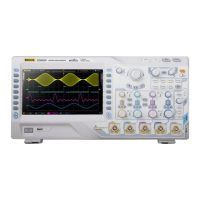Chapter 5 Trigger RIGOL
MSO4000/DS4000 User’s Guide 5-1
Chapter 5 Trigger
To generate a trigger, you set a trigger condition according to the requirement; when
a waveform in the waveform stream meets this condition, the oscilloscope captures
this waveform as well as the neighbouring part immediately and then displays the
captured waveforms on the screen. The digital oscilloscope samples waveform data
continuously no matter whether it is stably triggered; but only a stable trigger can
guarantee stable waveform display. The trigger circuit guarantees that each time
sweep and sample start when the input signal meets the trigger condition defined by
users; namely each sweep and sample are synchronous and the waveforms acquired
overlap to display a stable waveform.
The trigger setting should be based on the features of the input signal; thus you
need to have some knowledge of the signal under test to quickly capture the desired
waveform. This oscilloscope provides abundant advanced trigger functions which can
help you to focus on the waveform details of interest.
The contents of this chapter:
Trigger Source
Trigger Level/Threshold Level
Trigger Mode
Trigger Coupling
Trigger Holdoff
Noise Rejection
Trigger Output Connector
Edge Trigger
Pulse Trigger
Runt Trigger
Nth Edge Trigger
Slope Trigger
Video Trigger
Pattern Trigger
RS232 Trigger
I2C Trigger
www.calcert.com sales@calcert.com1.800.544.2843
0
5
10
15
20
25
30

